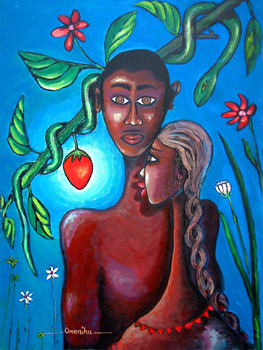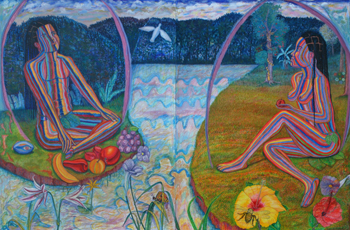For Sunday October 7, 2018
Lectionary Readings (Revised Common Lectionary, Year B)
Genesis 2:18-24
Psalm 8
Hebrews 1:1-4, 2:5-12
Mark 10:2-16
The 20th century Swiss theologian Karl Barth is quoted as saying, “One must do theology with the Bible in one hand, and the newspaper in the other.” I agree with him; I want my engagement with the world to reflect and inform my engagement with Scripture. But sometimes, the task of connecting Text and World is hard. The gap between the God-ordained reality I long for and the human reality I live in feels impossible to bridge. Sometimes, it hurts too much to hope.
Perhaps like many of you, I spent hours this week listening to, reading about, and reeling from the events unfolding in Washington D.C. At the time of this writing, Dr. Christine Blasey Ford and Judge Brett Kavanaugh have each testified before the Senate Judiciary Committee, and the FBI has been given one week to investigate Ford’s claim that Kavanaugh sexually assaulted her when they were both students in high school. Since last Thursday’s hearing, the nation has virtually exploded in pain, rage, doubt, and frustration. I can’t sift through the headlines fast enough. Social media — both conservative and liberal — is awash in grief and fury. As a country and as a culture, we are bleeding out.
Needless to say, I have no idea what the FBI investigation will reveal, or how this ordeal will end. My intention here is not to challenge or offend anyone’s political sensibilities. All I know is that I’m heartbroken, exhausted, and angry. As a woman, as a childhood victim of sexual abuse, and as a survivor who just spent days remembering in vivid detail what it felt like to be silenced, threatened, and dismissed by the people I hoped would protect me, I’m struggling to find a way forward. I’m struggling most of all to come to God’s Word with hope. I crave a word that is relevant. I crave a word that will heal. So I hold the Bible in one hand, the newspaper in the other, and pray to hear God’s voice in the cacophony of this moment.
The lectionary this week pairs a familiar portion of the creation story in Genesis with Jesus’s teaching on divorce in the Gospel of Mark. While these texts are straightforwardly about marriage, I think they offer us a broader vision as well. They speak to all human relationships, to the ways in which we see, treat, protect, harm, empower, and disempower each other. If we read them with an open mind, they offer us a meaningful and timely commentary on our common life.
 |
In the beginning (the Genesis passage tells us) God saw a grave problem. In the midst of lavish, freshly designed goodness, God paused, looked around, and frowned. “It is not good,” he said. “It is not good for a human being to be alone.”
Of course, the human being wasn’t alone. The human being had God, presumably the best companion of all, the companion in whose very image the human being had just been made. Moreover, the human being had all of Creation — sweet, uninterrupted communion with the birds, the animals, the trees, the flowers, the waterfalls, the mountaintops, and the oceans. And yet. “It is not good,” God said.
In response to the problem, God dreamed a wild dream. A dream of likeness. A dream of partnership. A dream of intimacy. When the dream was realized — when God brought Eve to Adam — the first human being cried out in a kind of joy that had never been heard on the earth before: “This at last is bone of my bones and flesh of my flesh,” Adam said. Here at last is a true equal. A companion. A friend. Here is someone I instinctively recognize — someone obviously as precious, as singular, and as priceless to me as own bones, my own flesh, my own self.
Human community began, Genesis tells us, with complete empathy and mutuality. God’s model for the human family was a model of equality and nurture. What Adam noticed first was not difference. It was similarity. Bone of my bones.
God’s initial dream for human relationship was so magnificent that several centuries later, when a group of Pharisees tested Jesus with nitpicky questions about the legality of divorce, Jesus referred them straight back to Genesis. The question is not a legal one, he told them. Not at its heart. At its heart, the question of all human interaction, all human community, is spiritual. What did God originally intend? What is God’s enduring dream? “That the two become one flesh.” That no one separates what God joins together. That we receive each other as equals, as partners, as intimates. That what we are to each other is not commodity, object, scapegoat, or conquest, but an extension of our own bones and flesh. Companions as essential, as vulnerable, and as worthy of tenderness and protection as our own bodies.
 |
That, Jesus reminded the Pharisees, was and is God’s dream, and what hinders the realization of that dream is our “hardness of heart.” In other words, the reason human relationships fail, the reason we wreak such destruction and brokenness on ourselves, is not because God’s dream is naïve, idealistic, or fantastical. It’s because we human beings are hard of heart. We trade partnership for power. Mutuality for manipulation. Empathy for egotism.
I need to pause here, because I know that these passages of Scripture are often applied only to marriage and divorce, and that many Christians feel judged and condemned by them. Just to be clear: I don’t believe that what Genesis describes and Jesus affirms in these readings is easy or even attainable for every couple who walks down the aisle and says, “I do.” To remember that God’s desire for human marriage is lifelong intimacy and companionship is not to suggest that God’s ideal is always possible, or that failing in marriage is a sin. It’s not.
What these readings give us is something beautiful and sanctifying to aspire to. They depict marriage as good — as good for us, and for the flourishing of goodness between us. God’s dream is that human relationships serve as dedicated, lifelong schools for love. Lifelong because it takes us flawed human beings at least that long to learn how to love well.
But Scripture also makes abundantly clear that God does not love any dream more than God loves us. His dream for marriage is not meant to trap us, wound us, diminish us, or condemn us. Adam’s cry at seeing Eve was a cry of pure joy, a cry of ecstatic recognition. But sometimes joy dies. Sometimes the familiar becomes unrecognizable. Sometimes intimacy ends in betrayal. When these things happen, there is grace and there is freedom. Always, always, always — there is both grace and freedom.
I started this essay hoping to find in the lectionary some balm for the political, social, and cultural pain we face this week. As I consider God’s longing for us to experience deep companionship (“It is not good for human beings to be alone”), as I reflect on Adam’s recognition of equality and mutuality (“Here at last is bone of my bones”) and as I absorb Jesus’s diagnosis of our current brokenness (“Because of your hardness of heart”), I mourn what we have become, and I cling to the hope that we can still become something better.
 |
What would it be like if “Boys will be boys” gave way to “Bone of my bones?” If the powerful recognized the Imago Dei in those who are powerless? If women ceased to be objects and became subjects? If conquest gave way to companionship, and legal bickering gave way to love?
At this particular moment, when so many of us feel tired, angry, and bruised, God’s dream for human community might feel like a pipe dream. Hardness of heart might feel easier and more accessible. Perhaps it is. But something in me thrills at the dream, even still, and I believe that’s because God planted the dream deep into our hearts a long time ago, and trusts us to keep it alive now. Bone of my bones. Flesh of my flesh. One humanity. Perfect joy. This is the dream we were created for. Let's not give up on it.
Image credits: (1) Fine Art America; (2) Saatchiart.com; and (3) ArtMajeur.com.





